Energy Efficiency: Basement
Use the navigation arrows or swipe (touchscreen) to view the displays for this area.
-
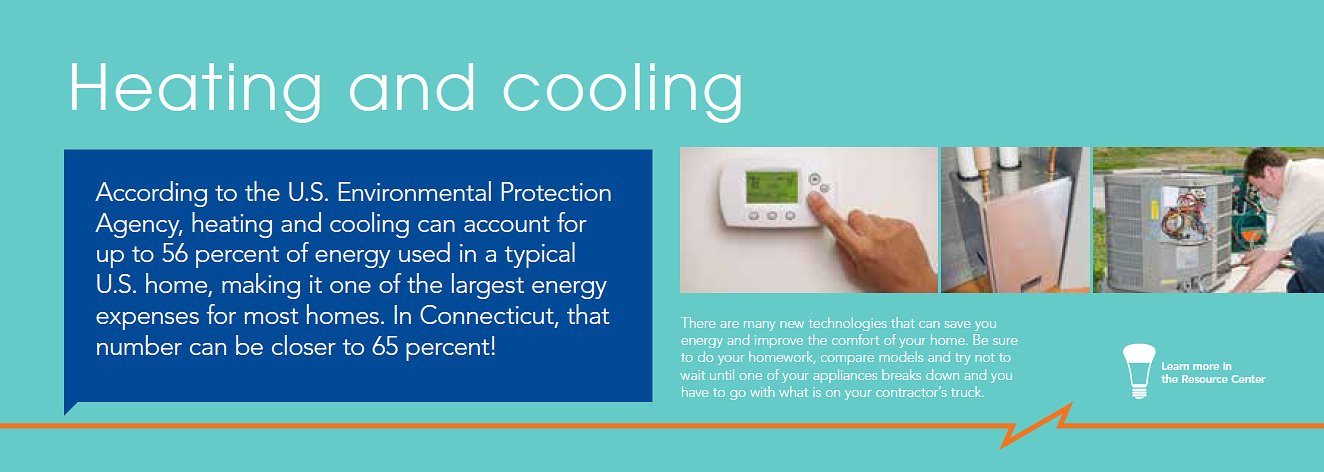
Heating and Cooling
According to the U.S. Environmental Protection Agency, heating and cooling can account for up to 56 percent of energy used in a typical U.S. home, making it one of the largest energy expenses for most homes. In Connecticut, that number can be closer to 65 percent!
There are many new technologies that can save you energy and improve the comfort of your home. Be sure to do your homework, compare models and try not to wait until one of your appliances breaks down and you have to go with what is on your contractor's truck.
-
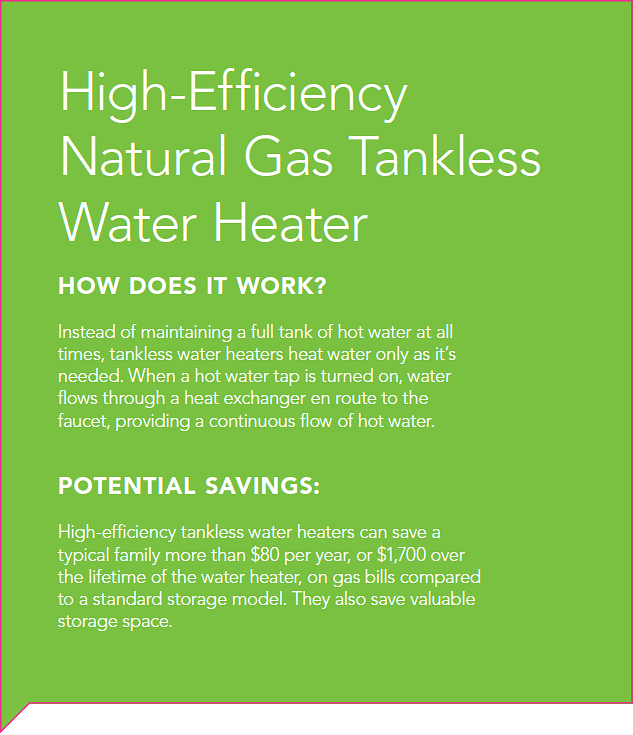
High-Efficiency Natural Gas Tankless Water Heater
What is it?
Instead of maintaining a full tank of hot water at all times, tankless water heaters heat water only as it's needed. When a hot water tap is turned on, water flows through a heat exchanger en route to the faucet, providing a continuous flow of hot water.
Potential Savings
High-efficiency tankless water heaters can save a typical family more than $80 per year, or $1,700 over the lifetime of the water heater, on gas bills compared to a standard storage model. They also save valuable storage space.
-
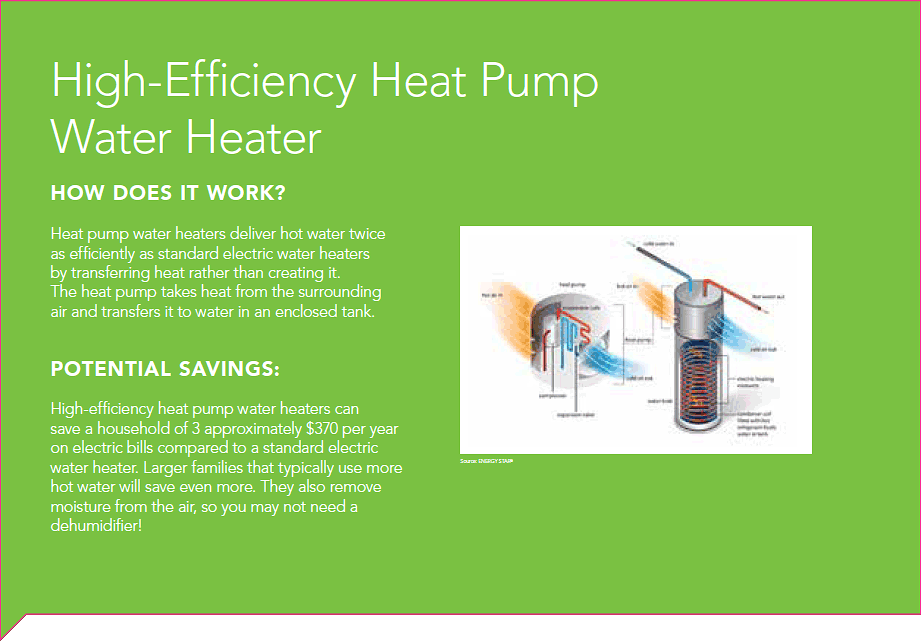
High-Efficiency Heat Pump Water Heater
What is it?
Heat pump water heaters deliver hot water twice as efficiently as standard electric water heaters by transferring heat rather than creating it. The heat pump takes heat from the surrounding air and transfers it to water in an enclosed tank.
Potential Savings
High-efficiency heat pump water heaters can save a household of 3 approximately $370 per year on its electric bills compared to a standard electric water heater. Larger families that typically use more hot water will save even more! They also remove moisture from the air, so you may not need a dehumidifier.
-
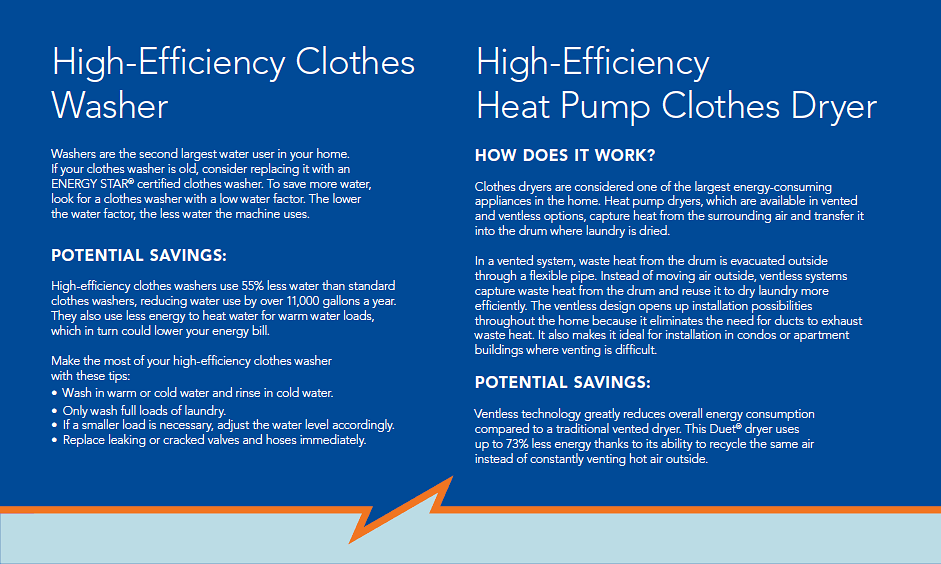
High-Efficiency Clothes Washer
Washers are the second largest water user in your home. If your clothes washer is old, consider replacing it with an ENERGY STAR® certified clothes washer. To save more water, look for a clothes washer with a low water factor. The lower the water factor, the less water the machine uses.
Potential Savings
High-efficiency clothes washers use 55% less water than standard clothes washers, reducing water use by over 11,000 gallons a year. They also use less energy to heat water for warm water loads, which in turn could lower your energy bill.
Make the most of your high-efficiency clothes washer with these tips:
- Wash in warm or cold water and rinse in cold water.
- Only wash full loads of laundry.
- If a smaller load is necessary, adjust the water level accordingly.
- Replace leaking or cracked valves and hoses immediately.
High-Efficiency Heat Pump Clothes Dryer
How Does it Work?
Clothes dryers are considered one of the largest energy-consuming appliances in the home. Heat pump dryers, which are available in vented and ventless options, capture heat from the surrounding air and transfer it into the drum where laundry is dried.
In a vented system, waste heat from the drum is evacuated outside through a flexible pipe. Instead of moving air outside, ventless systems capture waste heat from the drum and reuse it to dry laundry more efficiently. The ventless design opens up installation possibilities throughout the home because it eliminates the need for ducts to exhaust waste heat. It also makes it ideal for installation in condos or apartment buildings where venting is difficult.
Potential Savings
Ventless technology greatly reduces overall energy consumption compared to a traditional vented dryer. This Duet® dryer uses up to 73% less energy thanks to its ability to recycle the same air instead of constantly venting hot air outside.
-

Ductless Split Heat Pump
How Does it Work?
During heating season, ductless heat pumps draw heat from outside air and move it inside. By tapping into existing heat in the air, they use less electricity to keep your home at a comfortable temperature. In the summer, they extract heat from the air inside your home and move it outside to provide cooling.
Ductless heat pump systems are effective for homes with open floor plans and for areas where ductwork does not exist or cannot be installed. Ductless heat pumps are versatile and easy to install as either a new, primary heat source or as a cost effective supplemental heating system. Their adaptability and ease of installation makes them a good choice for home remodel projects, additions and new construction.
Potential Savings
Studies have shown that ductless heat pumps can reduce heating and cooling costs 25 to 50 percent, especially for homes that currently heat with electric resistance. Installation costs are also low compared to standard systems.
Geothermal Heat Pump
How Does it Work?
A geothermal heat pump takes advantage of the Earth's constant temperature to provide highly efficient heating and cooling. In the winter, fluid circulating in underground pipes carries the Earth's heat to your home, where it is concentrated to provide heating. In the summer, the process is reversed, carrying heat from your home back into the ground through the pipes to provide cooling. Some systems can also heat water.
Potential Savings
Geothermal systems use electricity to operate the heat pump, ground loop pump and distribution fan or pump, but because they are taking advantage of the Earth's constant temperature, they can reduce energy costs by 20 to 70 percent. These systems operate safely and quietly, with no combustion, direct emissions or exposed outdoor equipment, such as a fuel tank. Because they are mechanically simple and all exterior equipment is below ground, protected from the weather, maintenance costs are often lower than other heating and cooling systems.
Energy-efficient Air Conditioning
Before upgrading your cooling equipment, be sure to reduce the need for air conditioning as low as possible. Be sure to insulate and seal air leaks. Get rid of inefficient appliances. Consider light-colored roofing and siding products, which can reduce cooling demand by 10-15%. Ceiling and house fans use less energy than air conditioning and can also provide desired comfort.
If your central air conditioning unit is more than 12 years old, replacing it with an ENERGY STAR® certified model could cut your cooling costs by 30%.
-

Keep track!
Programmable Thermostats
Trim your energy bill by reducing your heating or cooling when you least need it. An automatic setback or programmable thermostat stores multiple settings corresponding to times when you are asleep, at work or away from the house, helping you save money without sacrificing comfort. Newer programmable thermostats have Wi-Fi capability and can allow you to control temperature remotely through your computer or phone.
-
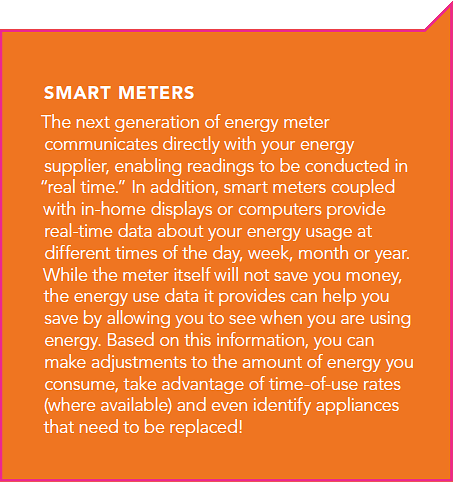
Keep track!
Smart Meters
The next generation of energy meter communicates directly with your energy supplier, enabling readings to be conducted in "real time." In addition, smart meters coupled with in-home displays or computers provide real-time data about your energy usage at different times of the day, week, month or year. While the meter itself will not save you money, the energy use data it provides can help you save by allowing you to see when you are using energy. Based on this information, you can make adjustments to the amount of energy you consume, take advantage of time-of-use rates (where available) and even identify appliances that need to be replaced!

- Energy Efficiency: Basement
:
- Heating and Cooling
- High-Efficiency Natural Gas Tankless Water Heater
- High-Efficiency Natural Gas Tankless Water Heater
- High-Efficiency Clothes Washer and Dryer
- Heat Pumps and Air Conditioning
- Programmable Thermostats
- Smart Meters
- Energy is All Around Us »
- Energy Basics: What is Energy? »
- Energy Basics: Sources of Energy »
- Energy Basics: Energy Pathways »
- Energy Basics: Electricity generation, transmission and distribution »
- Energy Efficiency: Why is it Important? »
- Energy Efficiency: In Your Home »
- Energy Efficiency: Lighting »
- Energy Efficiency: Kitchen »
- Energy Efficiency: Home Insulation »
- Energy Assessment »
- Sustainable Business »
- Electricity in Connecticut »
- In Your Community »
